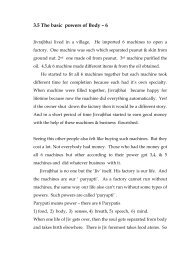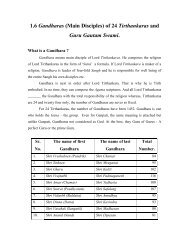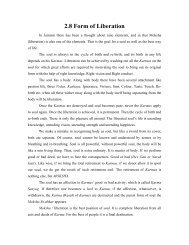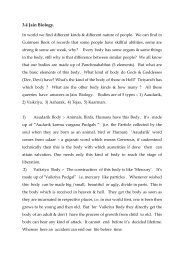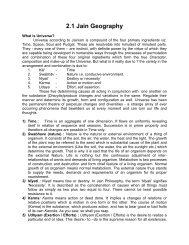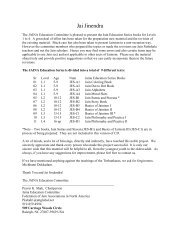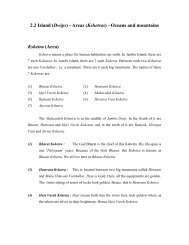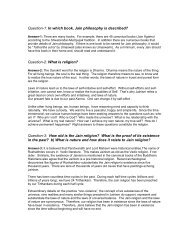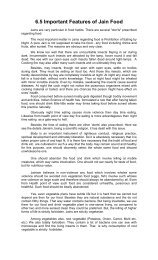Paryushan Parva - Jainism, Jain Religion - colleges
Paryushan Parva - Jainism, Jain Religion - colleges
Paryushan Parva - Jainism, Jain Religion - colleges
Create successful ePaper yourself
Turn your PDF publications into a flip-book with our unique Google optimized e-Paper software.
Sämäyik in English with Meaning<br />
State of Equanimity<br />
Six Essential Rituals<br />
Contemplation of the soul is the main part of <strong>Jain</strong>inism 2 . Contemplation of the soul includes<br />
thinking, analyzing and meditating in addition to practicing the right conduct. Tirthankars have<br />
expounded many ways to free our selves of passions (anger, ego, deceit and greed) and, as a result,<br />
attain Moksha. One of the ways is expounded in six Ävashyaka. Practicing six essential rites with<br />
true feeling, one begins to free him/her-self of passions and helps progress spiritually. These six<br />
essential rites are to be practiced daily.<br />
1. Sämäyik – Equanimity, to remain calm and undisturbed, to discard all sinful activities and to<br />
engage in spiritual activities to be free of all passions, not to have feeling of liking or disliking, no<br />
attachment, no desire, no aversion. Sämäyik is the process that enhances the quality of equanimity.<br />
The process that takes one closer to the soul is Sämäyik. In brief, Sämäyik is the state of equanimity.<br />
From the realistic point of view, Sämäyik is the state of purified soul. It implies evenness of mind<br />
and temper.<br />
Spiritually, time spent in equanimity is the only successful time, and all other times are wasted. No<br />
one has attained Moksha 3 , no one is attaining Moksha, and no one will attain Moksha without the<br />
practice of Sämäyik. To treat all living beings equal is the Sämäyik. To abandon the spiritually<br />
wrongful activities, and practice the spiritually right activities is Sämäyik. Sämäyik is the true<br />
conduct. Sämäyik is the essence of Tirthankar’s 4 teachings. Soul is Sämäyik. One has to practice<br />
Sämäyik to attain right perception, right knowledge and right conduct. <strong>Jain</strong> monks and nuns are<br />
supposed to be in the state of equanimity (Sämäyik) through out their life. Good Shrävaks 5 practice<br />
Sämäyik everyday. There is a great detail on the subject of Sämäyik in the <strong>Jain</strong> canonical books.<br />
One should try to practice at least one Sämäyik a day, if not more. Time spent in Sämäyik is time<br />
spent as a Sädhu 6 .<br />
2. Chaturvimshati-Stav - Praying and appreciating the qualities of the twenty-four Tirthankars.<br />
2 <strong>Jain</strong> word is derived from Jina, which literally means "the Victor" or “the Liberator”. One who has freed<br />
himself/herself from the bondage of Karma by conquering räga (attachment - deceit and greed) & dvesha (aversion -<br />
anger and ego). People who follow the teachings of Jina are called <strong>Jain</strong>s. <strong>Jain</strong>s are also called shramanas (who treat<br />
everything with equanimity) or nirganthas (who does not have desires and passions). The teachings of Jina is called<br />
<strong><strong>Jain</strong>ism</strong>. Lord Mahavira was the last reformer of <strong><strong>Jain</strong>ism</strong>.<br />
3 Moksha = moha + kshaya; moha means delusion and kshaya means eradication - this makes Moksha as the state where<br />
there is no delusion and all karma are eradicated. There are three jewels, samyak-darsana or right perception<br />
(inclination or belief), samyak-jnäna or right knowledge (cognition), samyak-chäritra or right conduct - these three<br />
combined are the means of Moksha.<br />
4 The word tirth means ford (passage) and, therefore, tirthankar means builders of ford which leads us across the ocean<br />
of suffering. In this half time cycle we had 24 tirthankars, first one was Rushabhdev and the last one was Mahävir<br />
Swämi. Tirthankar has revealed the truth of the universe to us.<br />
5 Shrävaka is the person who is living in a house and practices the partial vows (anuvrata). The shrävaka word is<br />
derived from the word “shru” meaning to listen. Shrävaka listens to the preaching of the tirthankar or the right guru or<br />
reads the <strong>Jain</strong> canonical books. Shrävaka has faith in the path of liberation expounded by the tirthankars, who avoids<br />
the non-essential activities of sins, who has the right belief, and who has suppressed anantänubandhi (life-long-lasting)<br />
kashäyas (passions). He/she feels that this material world (samsär) is a prison and wants to be freed from it.<br />
6 A male person who renounces the worldly life (takes dikshä) is called a monk or Sädhu, and a female is called a nun or<br />
sädhvi.<br />
4




